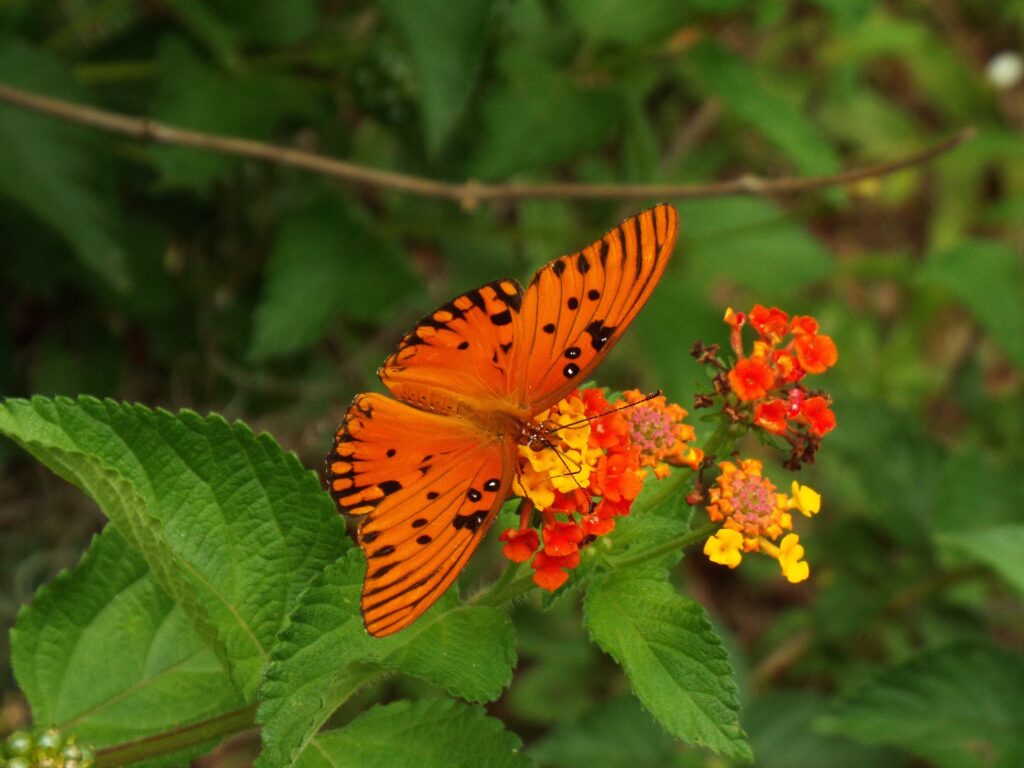
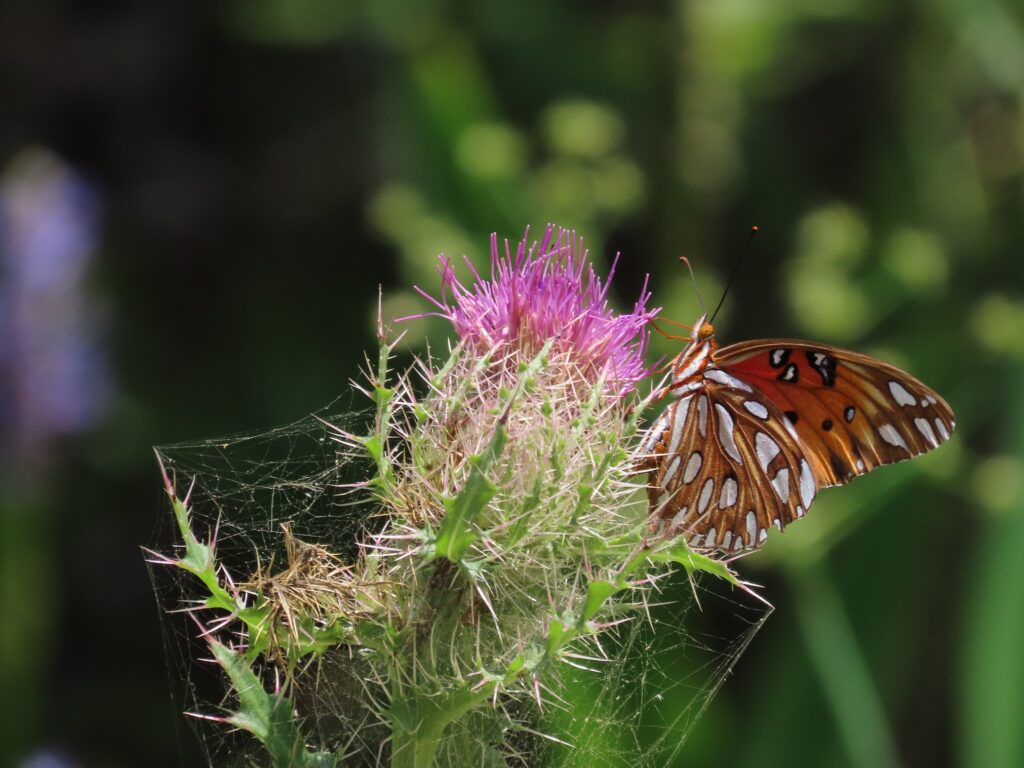
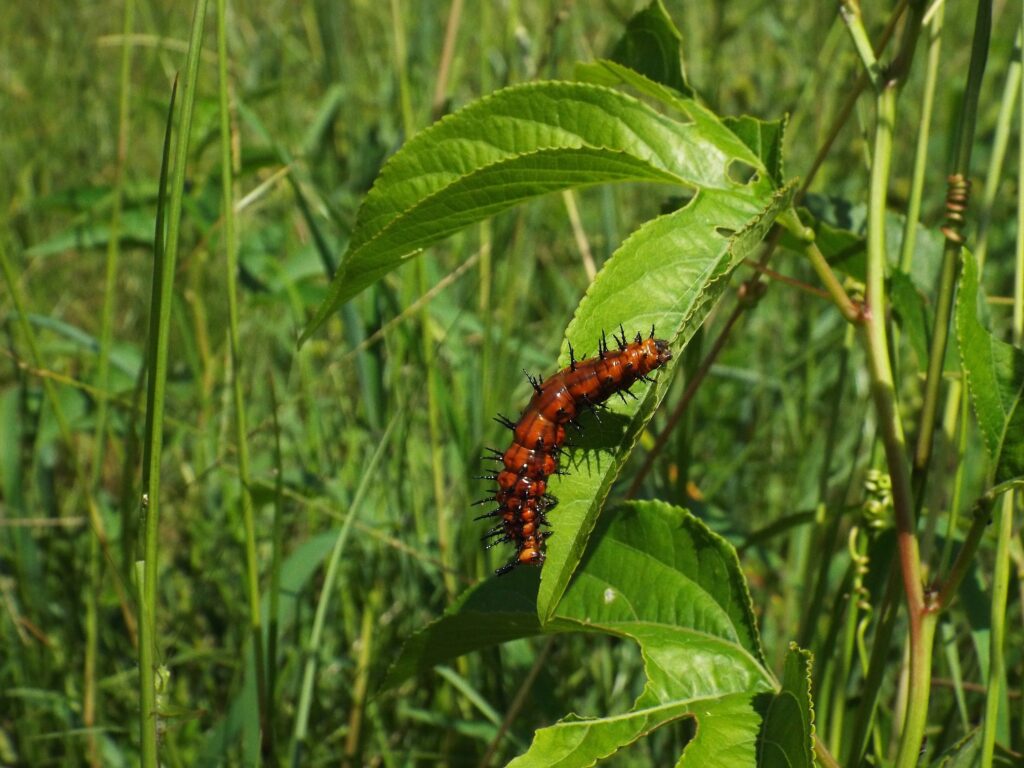
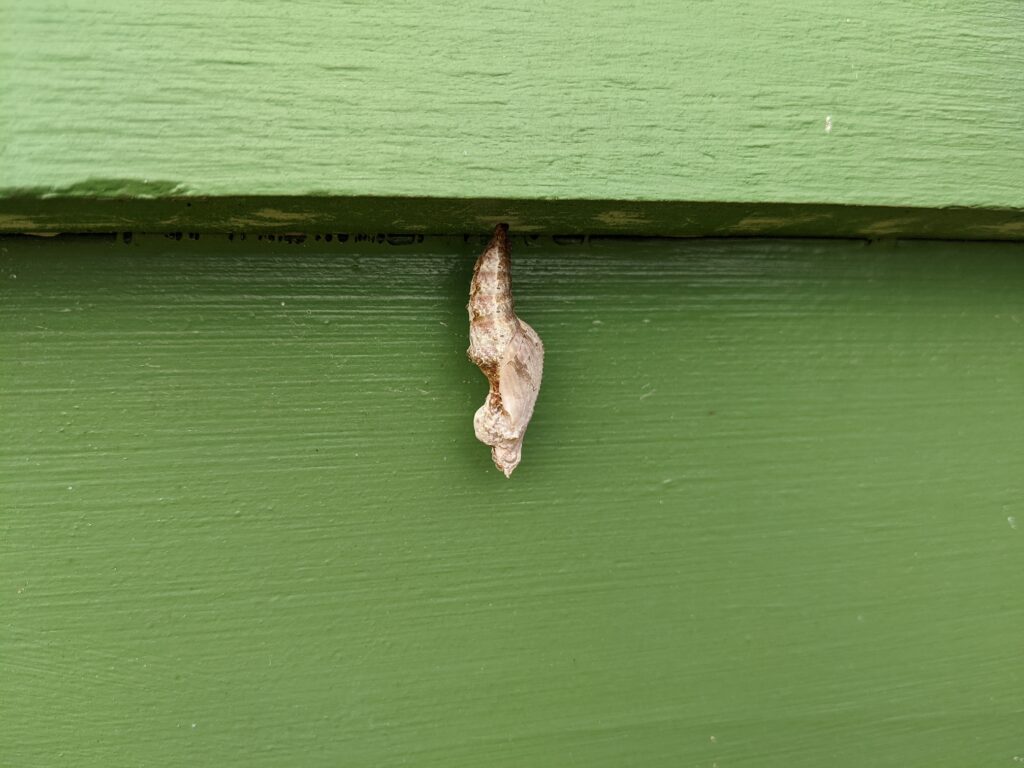
This week for Flora and Fauna Friday we have an orange tropical tourist, the Gulf Fritillary (Dione vanillae).
A cinnamon-orange sheet glides upon a flower top, soon to fold and hold aloft a stained glass pane of silvered whites soldered into bronze. The Gulf Fritillary is one of our most prolific and photogenic summer butterflies. It’s a large butterfly, usually three-inches wide. Its upper surface is a uniform palette of warm cinnamon-orange fringed and framed with graphite-black spots and veins and accented by three white spots, ringed in black, on the leading edge of the forewing. Beneath the wings it’s far more dynamic. That cinnamon-orange burns through in the center of the forewing but is elsewhere replaced with warm-bronze. Within the bronze are set great globs of pure-white, which have been likened to the patterning of stained glass. From beneath, thick white stripes can also be seen across the length of this butterfly’s body. The caterpillar of the Gulf Fritillary is also quite striking. It is a rich, glossy orange and staked across its entire length with black, thorned spines. This bright orange aposematic coloration on both larvae and adults hints that this species has a toxic defense. Gulf Fritillary caterpillars feed on Passionflowers (Passiflora spp.) and these vines contain toxic compounds to ward off insects and other herbivores. However, Fritillaries are able to tolerate these toxins, sequester them in their own bodies, and themselves become toxic.
Gulf Fritillaries are common on Edisto Island in the summer and are especially numerous in fall. They are regular visitors to flower gardens and will land on almost all large flowered plants. They are also quite prolific along roadsides, fence rows, farm fields, and pastures where they prowl for Passionflowers to besiege. Our Gulf Fritillary population balloons in fall because this species is one of our tropical migrant butterflies. Although we have many pockets of resident populations, most of our Gulf Fritillaries are coming up from Florida for the summer. As the butterflies multiply in the spring in sub-tropical Florida, they eventually start flying north. By mid-summer they begin to arrive on Edisto Island and by October they’re arriving here in droves! The butterflies that migrate don’t return south. Instead they lay eggs in hopes that their children can find a foothold the following spring.
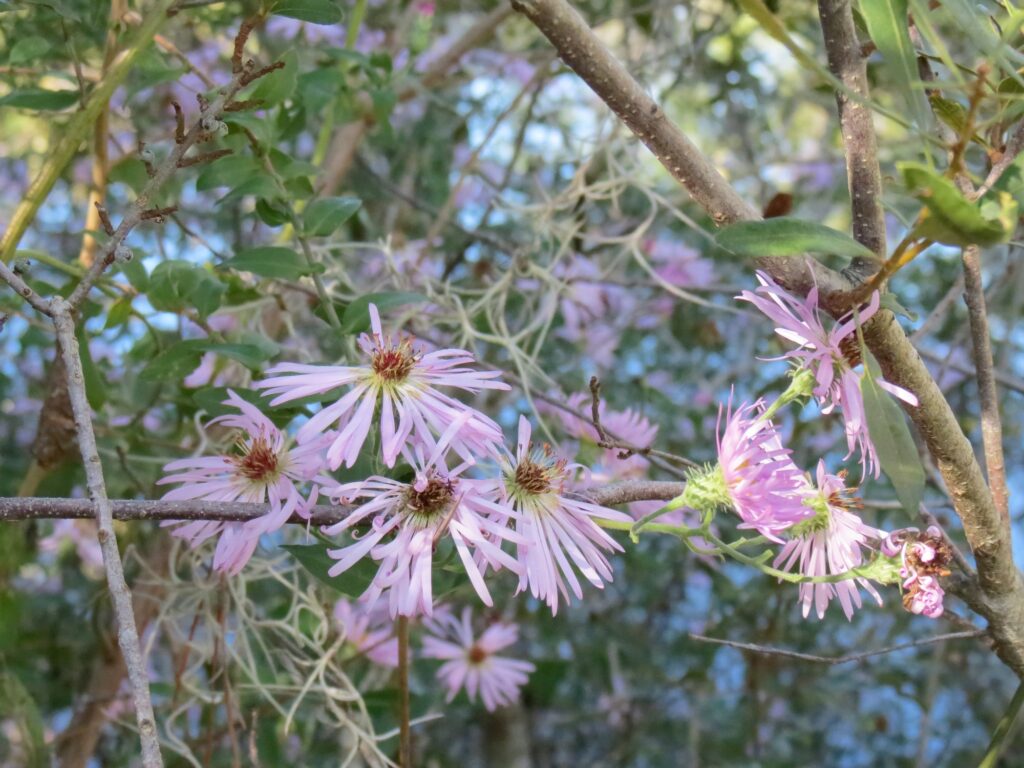
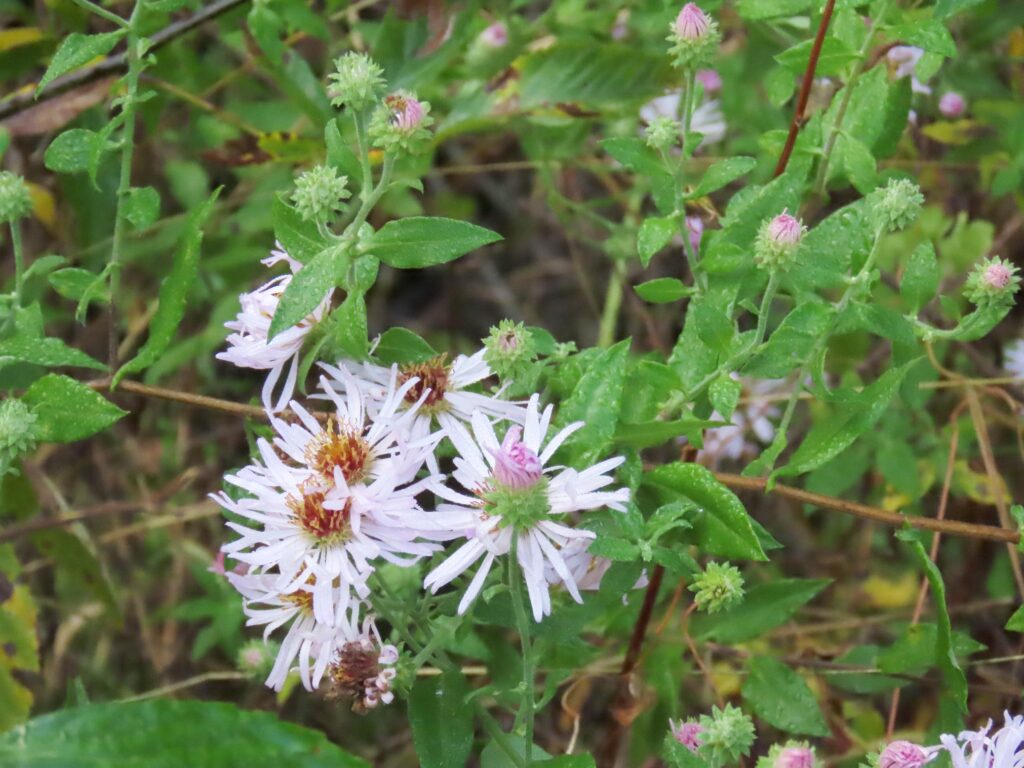
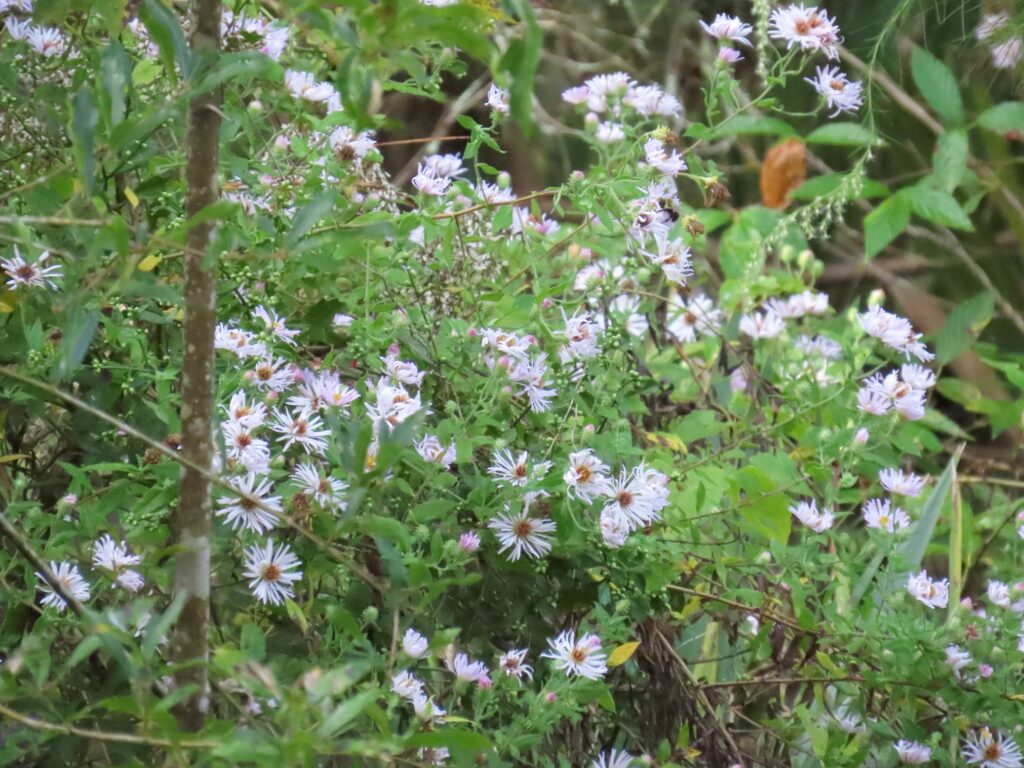
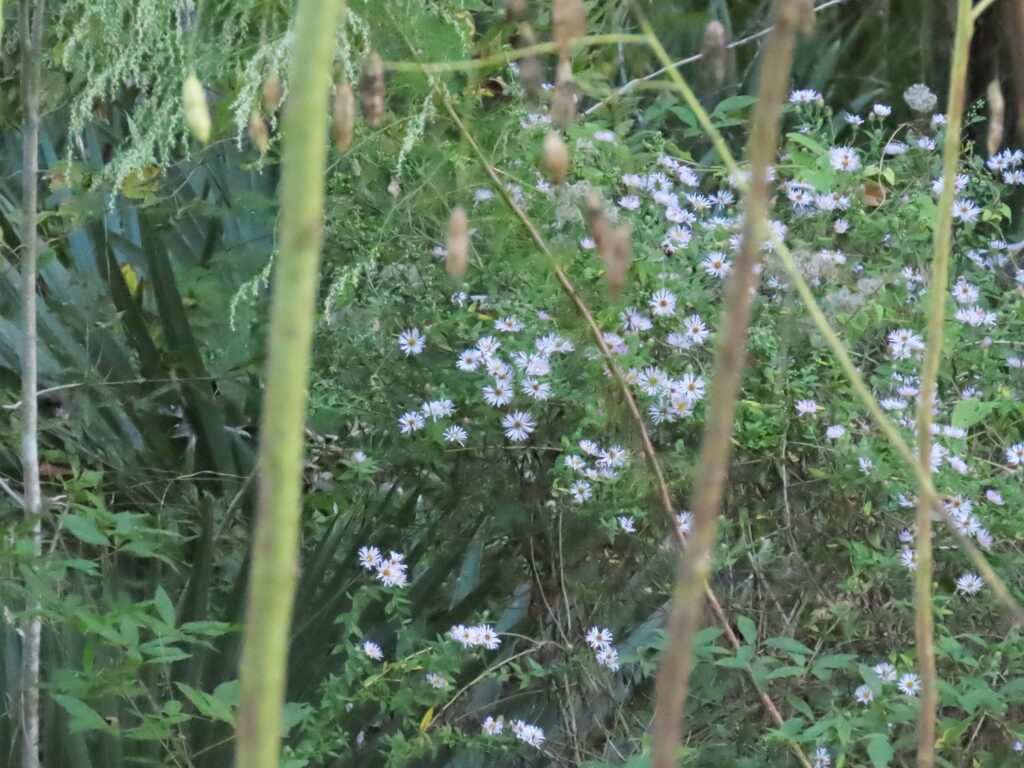
This week for Flora and Fauna Friday we have a wildflower with a mild identity crisis, Climbing Aster (Ampelaster carolinianus).
Climbing Aster is an aster through and through, with its simple, ovate leaves, stiff but narrow stems, and its golden composite flowers ringed in innumerable, pink-blushed-white petals that settle to pastel-magenta in the waning days of fall. Yet, its behavior au contraire to its nature. Climbing Aster creeps along and climbs upon its surroundings before, foothold assured, it heaps itself atop some pillar of its local botanical community. It lives its life not as a self-supporting shrub but as an unkempt, intruding vine. Climbing aster is partial to wetland margins, particularly pond sides, freshwater marshes, and seas island swamp shores. It is most abundantly in these locales when on the immediate coast of the South Carolina Lowcountry. When establishing, it often digs its heels in on the water’s edge before stretching itself out on top of the nearby greenery and grasses to soak up the unobstructed sun, as it dangles safely above the subverted quagmire below. Despite its mooching motivations, Climbing Aster is among the showiest of our asters. Its flowers are large for an aster, at up to an inch-and-a-half and numerous across the entire plant. It’s also one of our latest flowering native wildflowers, blooming well into November and providing a final feast for any straggling pollinators.
This week for Flora and Fauna Friday is everyone’s favorite group of scaly, maraca-wielding sausages: the Rattlesnakes of genera Crotalus and Sistrurus.
Here in the Lowcountry we have three species of Rattlesnake belonging to two genera: Canebrake Rattlesnake (Crotalus horridus), Eastern Diamondback Rattlesnake (C. adamanteus), and Pygmy Rattlesnake (Sistrurus miliarius). All are venomous, stout, mainly nocturnal, and can see body heat. Their toxic teeth lend well to similar lifestyles of ambush hunting but all have carved out a special niche.

The Canebrake Rattlesnake, AKA Timber Rattlesnake, is our most common Rattlesnake and can reach five feet long. Their scales are a brassy-gray across leading to a black tail tip with dark jagged rings around their belly and a rusty stripe down their spine. Canebrakes are widespread throughout our woodlands, thickets, and fields. Their diet is primarily mice, rats, squirrels, and rabbits but they will eat what they can catch, even other snakes. Timber Rattlesnakes usually smell out a mammal’s favorite footpath and then set up shop on the shoulder. When the critter finally passes by, hours, days, or weeks later, their infrared sensing pits let them seize it in a heartbeat, even in pitch darkness. The Canebrake’s venom is deadly. So you should try and avoid getting bit when out in the bush! Luckily, Canebrakes have a fairly laid back demeanor and hardly react to the presence of humans, except to rattle their tail when they’re cruising by, just to let you know they’re watching you. Rattlesnake rattles are made of hollow interlocking pieces of keratin. A rattle is added when the snake sheds its skin.
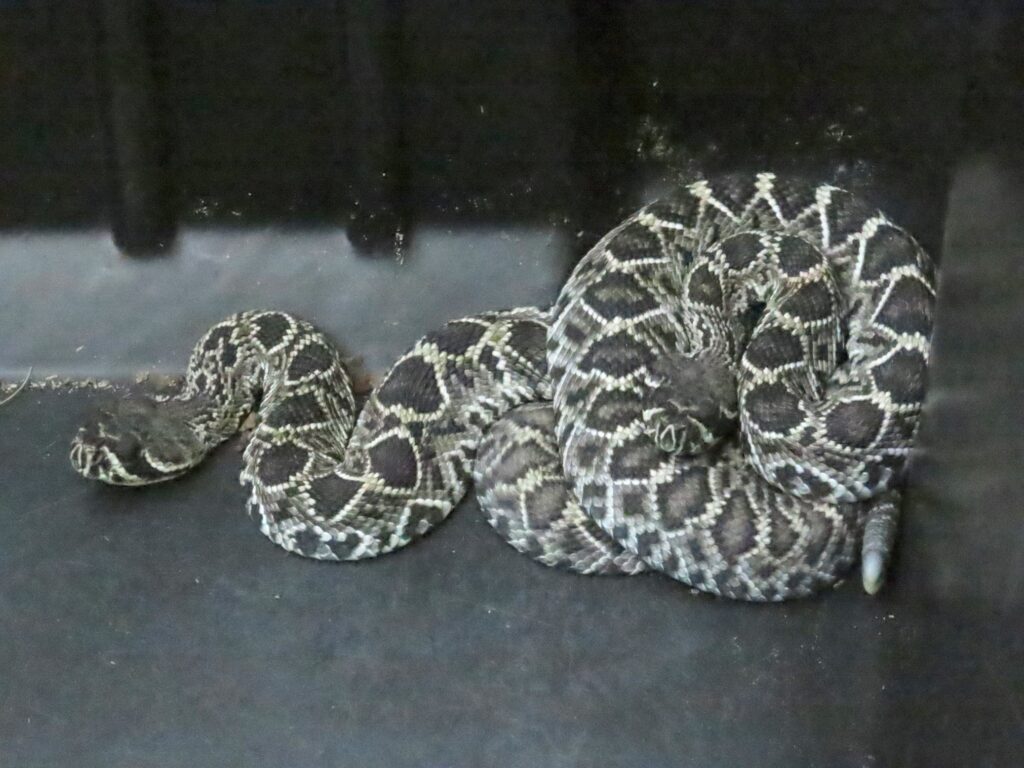
The Eastern Diamondback Rattlesnake is our largest venomous snake at up to seven feet long and a contender for the world’s heaviest venomous snake. They’re a species of conservation concern in South Carolina due to habitat destruction and human persecution. Their scales are tan and brown leading to a black tail tip and studded down the top with black diamonds bordered by white. Diamondbacks are most common on barrier islands and in pine savannas. They are strong swimmers as well, allowing them to cross between islands. Fox and Gray Squirrels, among other furry critters, are their favorite foods. Their method of ambush is the same as that of the Canebrake but their attitude is more defensive. Some Diamondbacks are quick to rattle and will shortly coil up, head held high, to signal that they mean business. This is mostly for show as they will usually only feint biting when approached. However, they have the most potent bite of any snake in North America, so this display is no bluff. Don’t get near a Diamondback unless you’re a trained professional!
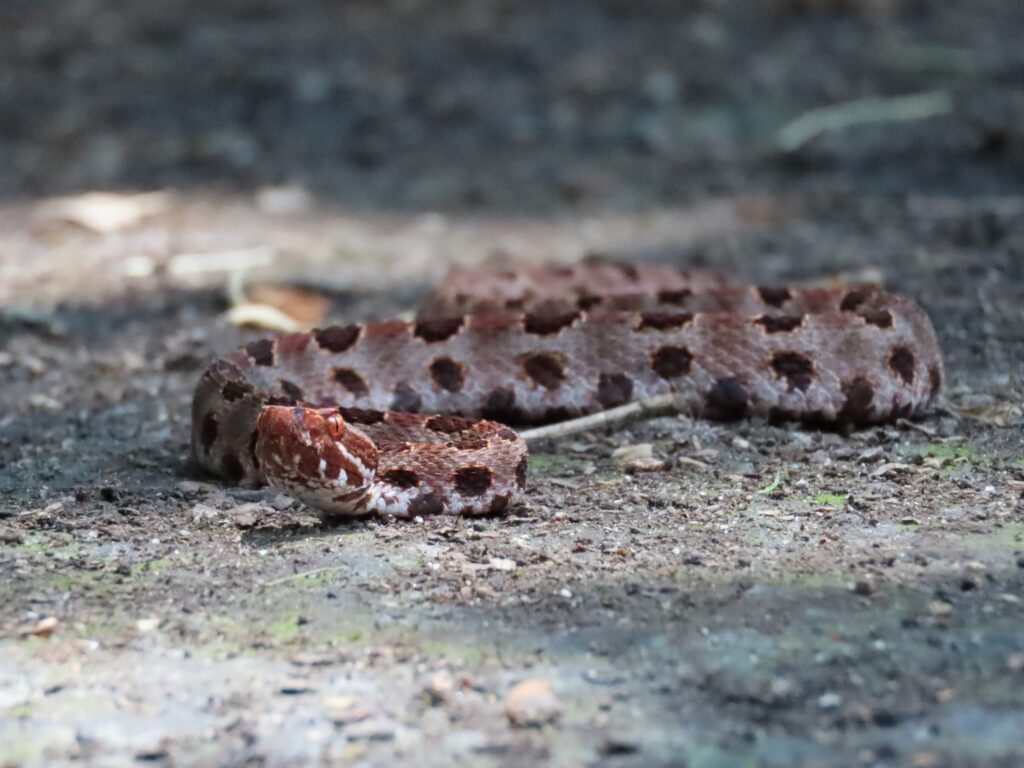
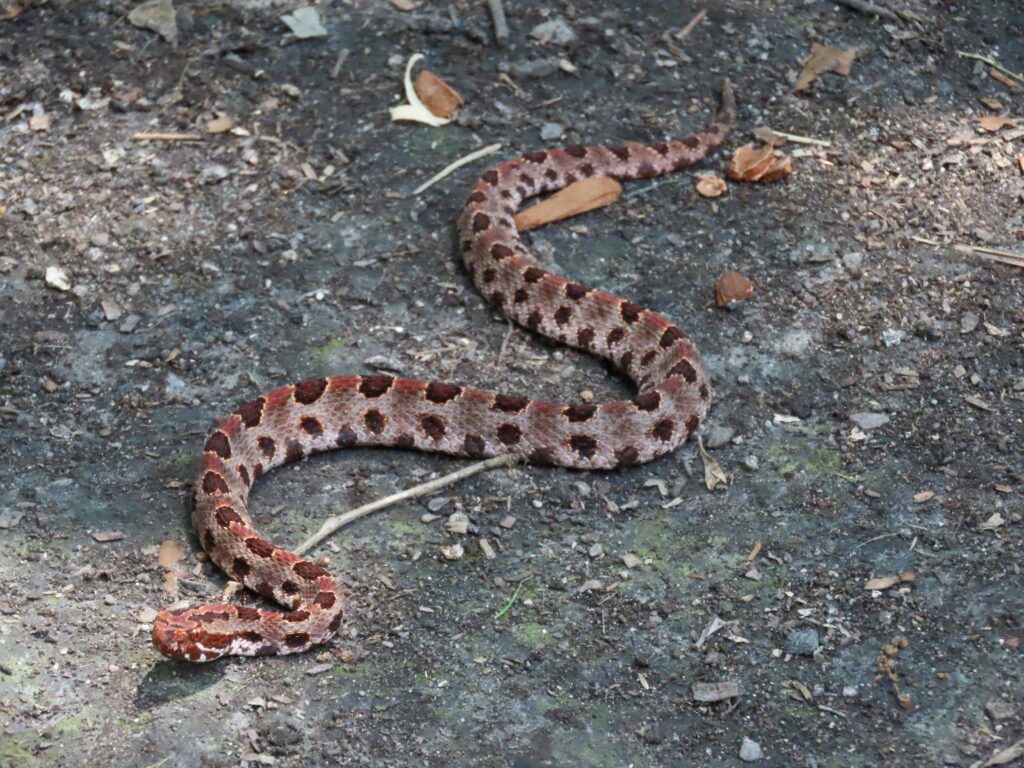
The Eastern Pygmy Rattlesnake is our smallest viper, at under two feet in length. They have pinkish-gray scales accented by small, dark, blocky-blotches and a rust-red stripe down the spine. Pygmies are most common in our pine forests, especially our flatwoods, and often hang out around freshwater wetlands. Like its two larger cousins, Pygmies are ambush hunters but mainly prey on small mammals, lizards, frogs, and insects. Unlike the larger rattlers, the Pygmy Rattlesnake doesn’t have much of a rattle and so it relies mainly on its camouflage to keep it out of harm’s way.
Rattlesnakes are a group of reptiles who want nothing more than to be left in peace. The number one cause of snake bites in the US is deliberately trying to handle or kill a snake. Although they can pose a hazard to energetic pets and carefree children, a Rattlesnake has no innate desire to bite people. They’re just a wild animal trying to get by without getting harassed. Venom is their last line of defense and they can’t guarantee it will save them. Think about it. A snake to a Bobcat or Coyote is just an angry kielbasa with scales. It looks like dinner. A snake without venom poses no threat. Even still venom takes minutes to take effect. Plenty of time to become something’s last meal. A Rattlesnake wants to make you aware that it is there so you will go elsewhere. It won’t touch you if you don’t touch it. So let the snakes be. Put the shovel down, holster the ratshot, drive around them, and for crying out loud don’t try and pick them up!
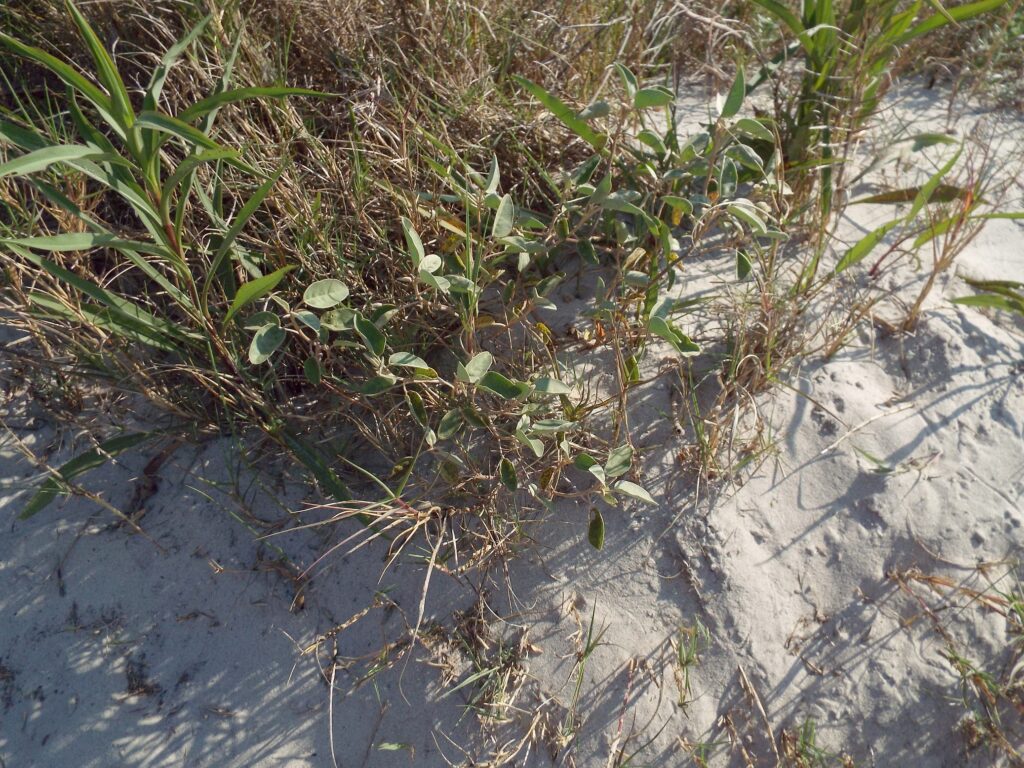

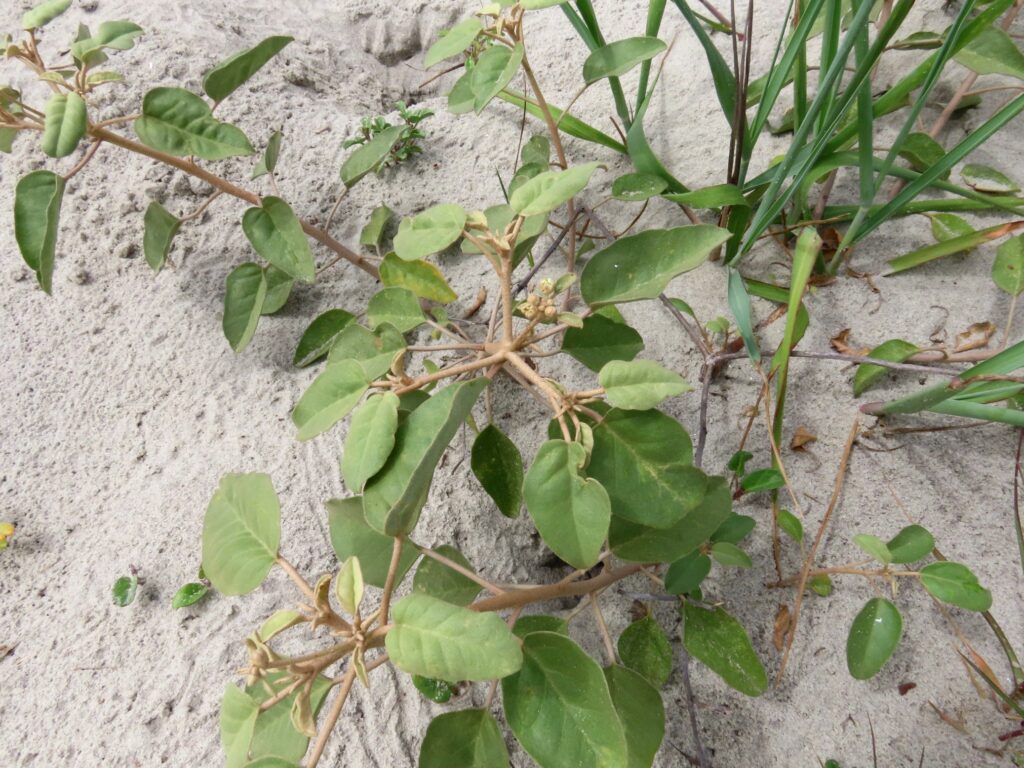

This week for Flora and Fauna Friday it’s the silvery seashore Gulf Croton (Croton punctatus).
Gulf Croton is a small, spreading, perennial shrub growing up to about knee high. It’s one of our beach specialist species, growing along the dunes right up to the front beach. Life on the beach is not a relaxing affair for plants, as it’s one of the harshest environments there is. Everything about a beach-bound plant must be precision tailored towards survival if they want to even stand a chance, and today’s plant is no exception!
Of course, any plant that lives on the beachfront has to be supremely adapted to extreme sunlight, droughty soils, constant wind stress, soil fertility extremes and deficits, saltwater inundation, and constant salt spray. Gulf Croton has all of those boxes checked. Its small size and supple branches help it resist the extreme winds of a beachfront and its spreading nature allows it to capitalize on good habitat once established. Gulf Croton’s leaves are thick and leathery, evergreen, and shaped like an inverted teardrop. This lets them reuse their leaves for multiple seasons and pump them full of water as storage for drier times. Gulf Croton is coated from ground to flower in a layer of fine silvery hairs and bronze resin dots. The silvery hairs act like insulation, protecting the plant from excess sunlight and buffering them against temperature swings. The resin dots are a chemical defense, pumped full of disagreeable substances to discourage insects and herbivores from chowing down. Gulf Croton blooms practically year-round and has male and female plants. The constant flowering allows Gulf Croton to take advantage of the stable coastal climate and, given their limited range, the unisexual flowers help them maintain genetic diversity by forcing cross-pollination. The flowers of Gulf Croton are small and innocuous, small silver orbs opening to a golden-green core with nary a petal in sight. Yet, they are still frequented by many pollinators, particularly native bees, as a reliable source of pollen and nectar.
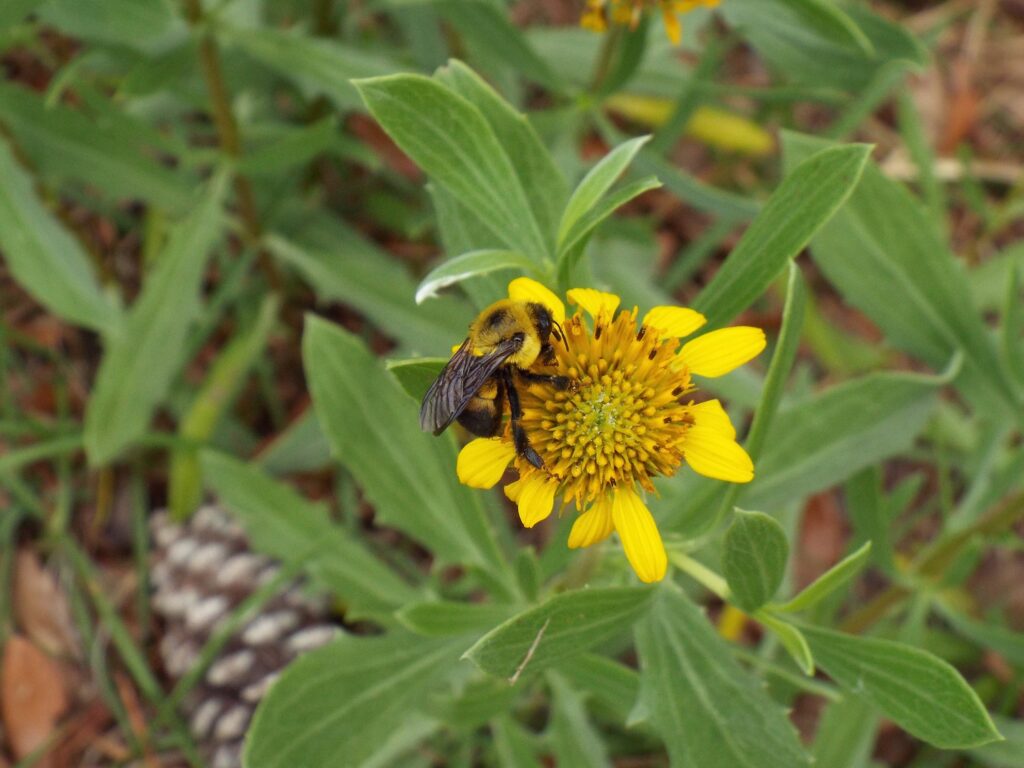
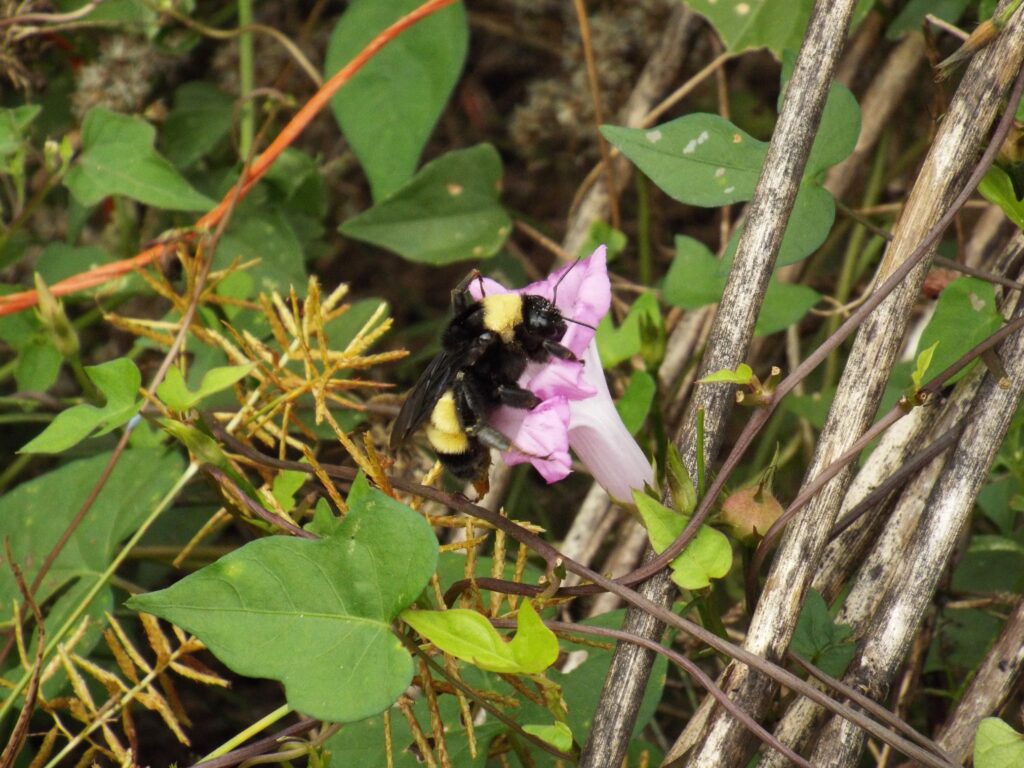
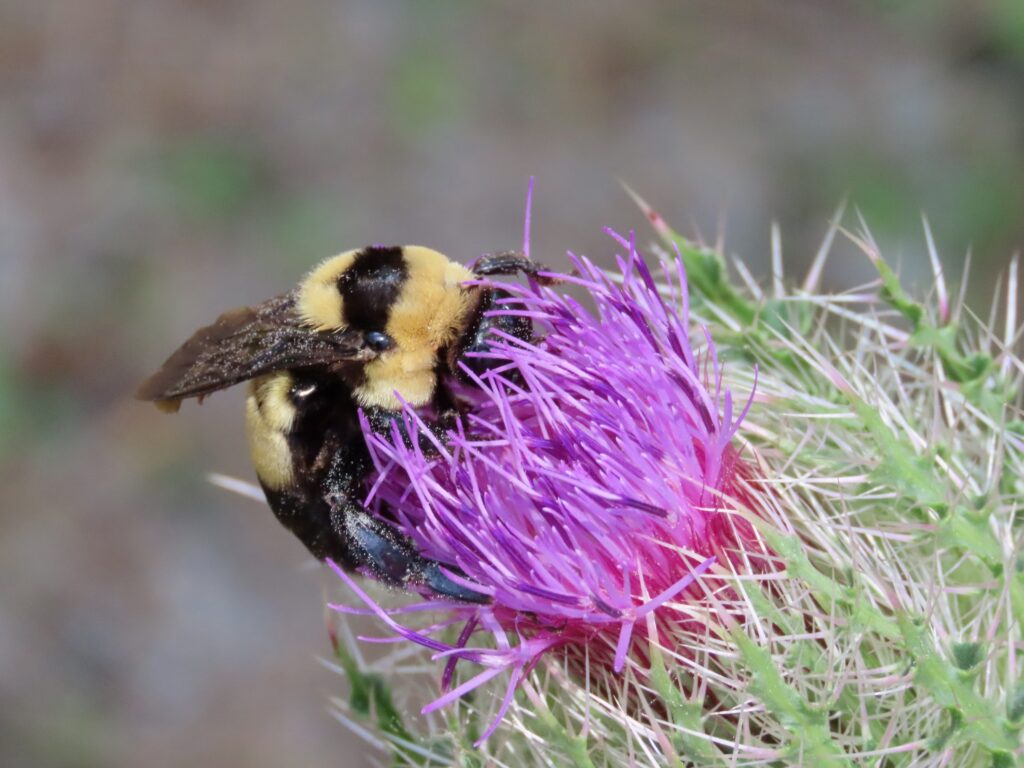
This week for Flora and Fauna Friday, we have our busy buzzy bicolored blossom buckling Bumblebees, of genus Bombus.
Here in the Lowcountry of South Carolina we have five species of Bumblebee. Each has that classic black and yellow coloration but they all vary slightly in the patterning it takes on. The Eastern Bumblebee (B. impatiens) is both our most common and our smallest species of Bumblebee, measuring one-half to three-quarters of an inch in length. It has a pastel yellow thorax with a small black spot in the middle, a single thin band of yellow around the waist, a yellow head, and a somewhat shaggy appearance. The Two-spotted Bumblebee (B. bimaculatus) [not pictured] is very similar to the Eastern Bumblebee but a skosh bigger, shaggier, and with a second partial waist band that is sometimes split into two spots. The Brown-belted Bumblebee (B. griseocollis) hovers around three-quarters of an inch in length with a similar pattern to the Eastern Bumblebee, except that it has no shagginess to its hairs, a black head, and a tan or brown, unbroken but partial second waist band. The American Bumblebee (B. pensylvanicus) is likely our second most common species. It’s up to an inch in length with yellow shoulders, two solid yellow waist bands, and sometimes a wash of ruddy-yellow on the lower thorax. The Southern Plains Bumblebee (B. fraternus) is our biggest bee of the bunch. It has a pastel-yellow thorax with a thick black band across the center and two solid, pale-yellow waist bands.
Like the domesticated Honeybee, Bumblebees are eusocial, colony forming bees. They have a queen who builds a hive and raises sterile daughters to help her run the colony. Unlike Honeybees, Bumblebee hives only last a year, they don’t build complex combs, and the colony can consist of a few dozen bees up to several hundred, depending on the species. Each spring, queens born the prior year emerge from hibernation and begin building their own hives. Bumblebees build their hives near, on, or under the ground. They’ll often build hives within a small burrow, stump, under leaf litter, or in a mound of dense grass. They build “pots” of wax which are either be filled with honey for storage or serve as cradles for baby bee larvae.
Like all bees, Bumblebees live on a diet of nectar and pollen they collect while visiting flowers. Our five Bumblebees are the powerhouses of pollination in the Lowcountry and, in concert with our other native bees, do the lion’s share of the work in spreading pollen between native plants. However, two of our native Bumblebees are on the decline. The American Bumblebee is listed as vulnerable and the Southern Plains Bumblebee is listed as endangered by the IUCN, the International Union for Conservation of Nature. Both species are being petitioned for listing under the Endangered Species Act. However, you can help out our native bees on Edisto Island with one simple trick, let your yard be messy! Bumblebees need more native wildflowers to find food and they need heavy vegetation and crevices to nest in. So if you let your yard and woodlot return to nature, you’ll be making space for our Bumblebees to thrive again, and you’ll be saving time and money on your landscaping bill!
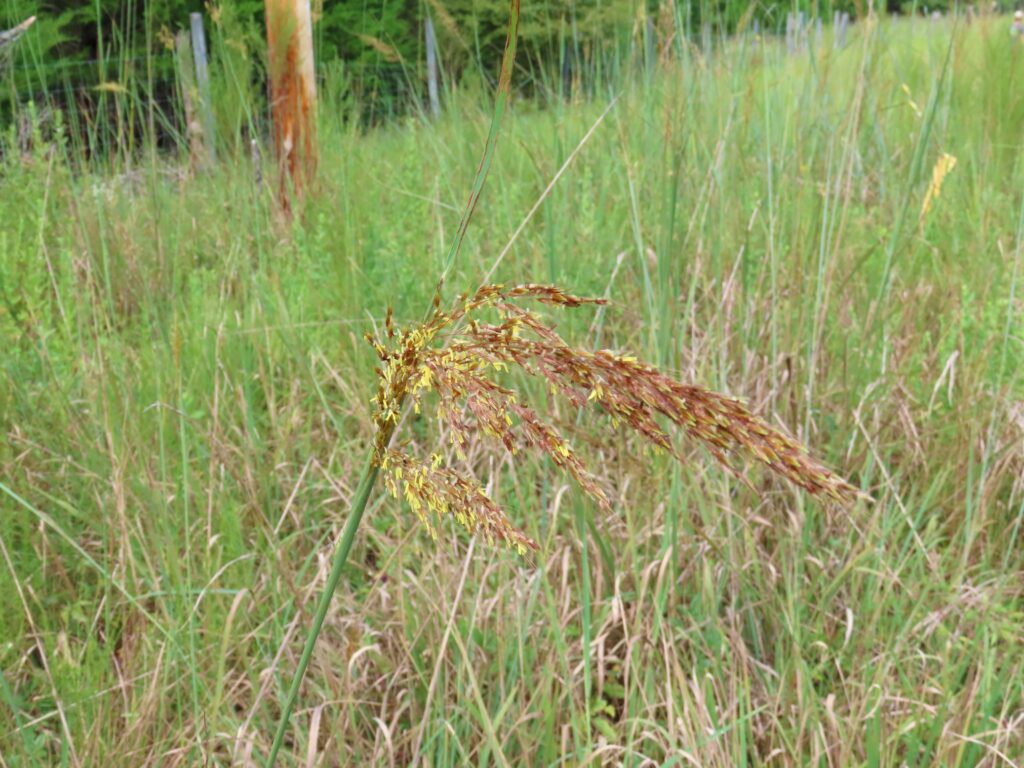
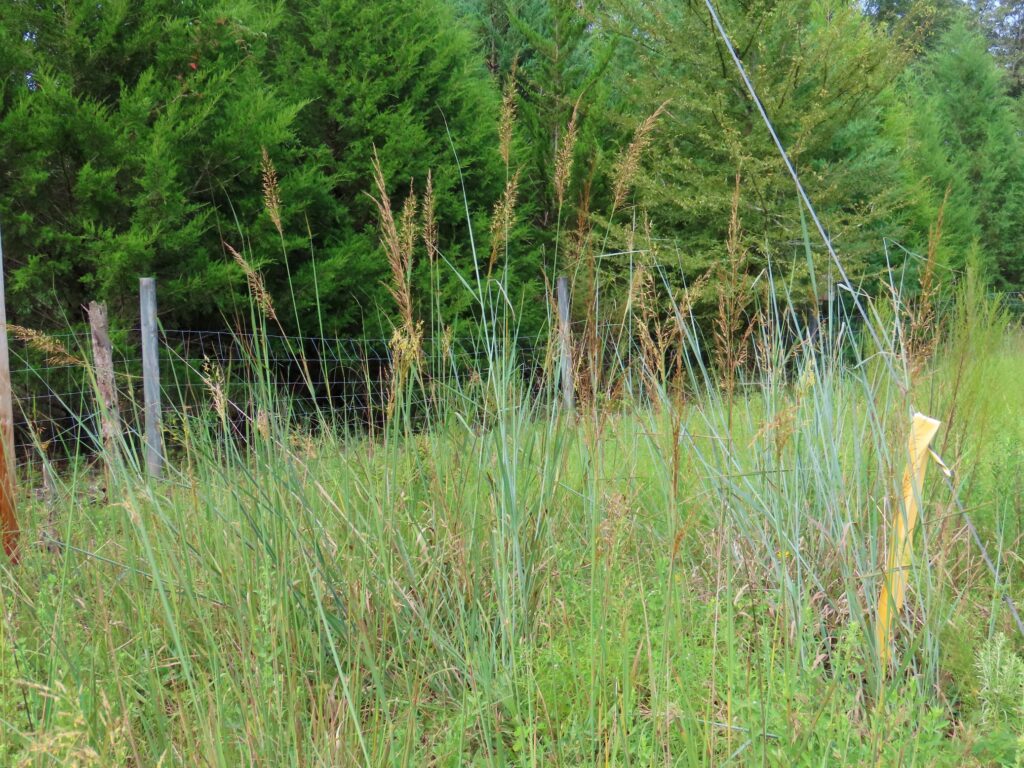

This week for Flora and Fauna Friday it’s a native warm-season grass of the southern savannas, Indiangrass (Sorghastrum nutans).
Indiangrass is a large native species of grass found throughout most of South Carolina. It’s sporadically found in savannas, prairies, roadsides, powerline cuts, oldfields, and other open habitats. It’s a bunch grass, meaning the plants grow as single large clumps. Foliage is about waist-level to chest-high and bluish-green. This grass flowers in September and October with small golden flowers in tight, narrow spikes held atop head-high stalks. These flowers mature into large, dense clusters of golden-brown, grain-like seeds. These seeds provide a valuable food source to small mammals and seed eating birds throughout the winter. It’s large, arching growth also provides great cover habitat for these small animals as well as nesting habitat for Bobwhite Quail. Indiangrass is an important ecological component of southern Longleaf Pine savanna ecosystems. It was once far more common in the Lowcountry than it is today. However, after centuries of habitat conversion and fire suppression, its abundance has dwindled across the landscape. However, it is a hardy and resilient species and, once it and fire are reintroduced to an ecosystem, it will prosper! It also makes a wonderful addition to yards with native plant landscaping.
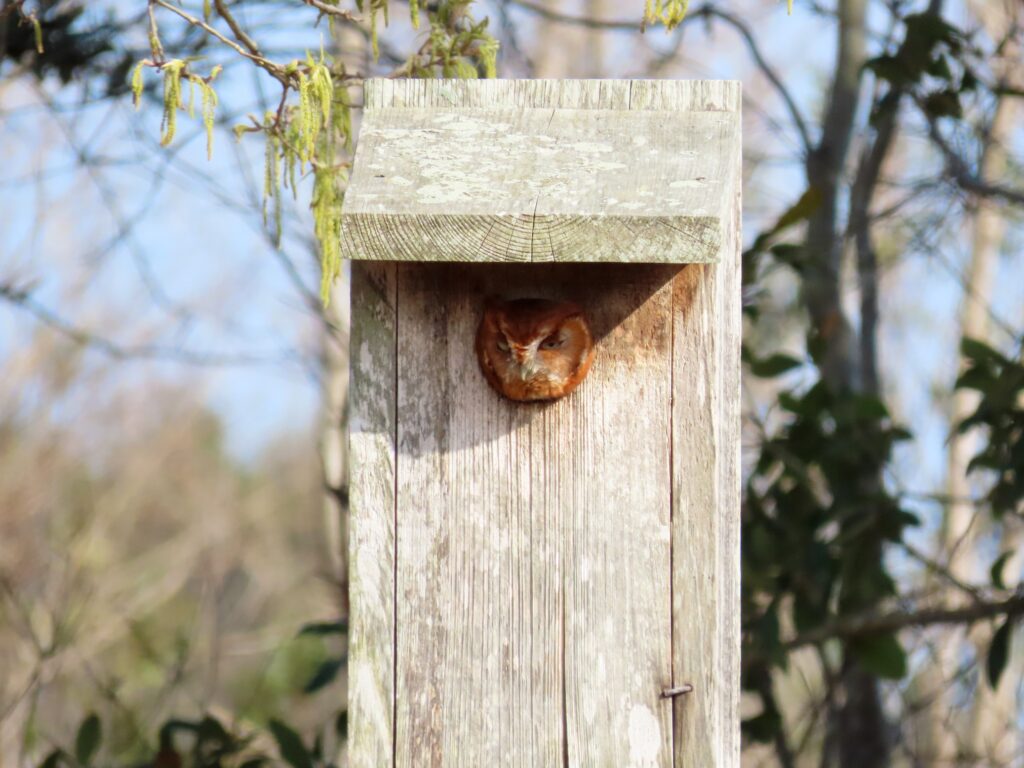



This week for Flora and Fauna Friday we’re listening in to the haunting call of a diminutive raptor, the Eastern Screech Owl (Megascops asio).
Whilst walking within woods in waning twilight, a whistling wraith-like whinny wrings a shiver up your spine and haunting pulsing laughter incites paranoia amidst the dark. The song of the Eastern Screech Owl creates an indelible memory in the minds of all who first hear it and strikes a chord of fear and fury in the hearts of many of our native songbirds. The Eastern Screech Owl is found year-round throughout the eastern and central United States. They inhabit woodlands and small groves of mature trees in open regions. Our Screech Owl is downright tiny for an owl. In fact, they’re practically songbird-sized and about the same heft as a Mourning Dove. They have all the trappings you’d expect of an owl, large eyes, broad face, hooked bill, upright posture, and talons, but condensed down into the size of just your outstretched hand! Eastern Screech Owls come in three primary color morphs: red, gray, and brown. Yet, all three flavors of our Owl share similar characteristics, to include pale-brass colored eyes, an ivory bill, a dark ring framing the lower face, darker vertical stripes down the belly, and prominent “horns” that they can lift up from their “eyebrows”. These features together lend themselves to giving Screech Owls some incredibly human-like expressions, which our brains can’t just can’t help but see! The Eastern Screech Owl has several distinct and unmistakable calls, each more haunting that the last. Their primary song is a bone-chilling, high-pitched, horse-like whinny. Their alternative song is a pulsating, monotonous, windy trill, like the echo of disembodied laughter. Lastly, their calls are a chaotic utterance of resonating puppy-like whines. Each will certainly leave an impression the first time you hear it!
Eastern Screech Owls, like all our other owls, are nocturnal predators. They hunt in the dead of night using their fantastically sensitive hearing and eyesight, swooping in to ambush unsuspecting prey on silent wings. Their diet consists largely of insects but also includes lizards, treefrogs, small mammals, small birds, and practically anything else they want to catch. Songbirds are particularly sensitive to the presence of Screech Owls and will mob and pester them in daylight hours if they catch wind of an Owl in the neighborhood. Screech Owls hunt both in open habitats and woodlands but are dependent on mature woodlands for nesting. Screech Owls are cavity nesters and depend on old nest holes carved in trees by our larger woodpecker species. The loss of mature tree snags suitable for nesting has caused Screech Owls to become scarce on the landscape. However, Screech Owls are a resilient species and have adapted to new opportunities in the modern world. They’re most common in mature hardwood forests but they’re not above moving into suitable woodlots amidst farmlands and suburban areas. Here in the Lowcountry, Screech Owls have also taken to commandeering Wood Duck boxes for nesting. So even if you don’t have any wetlands, you may want to consider putting up a duck box, but for owls!
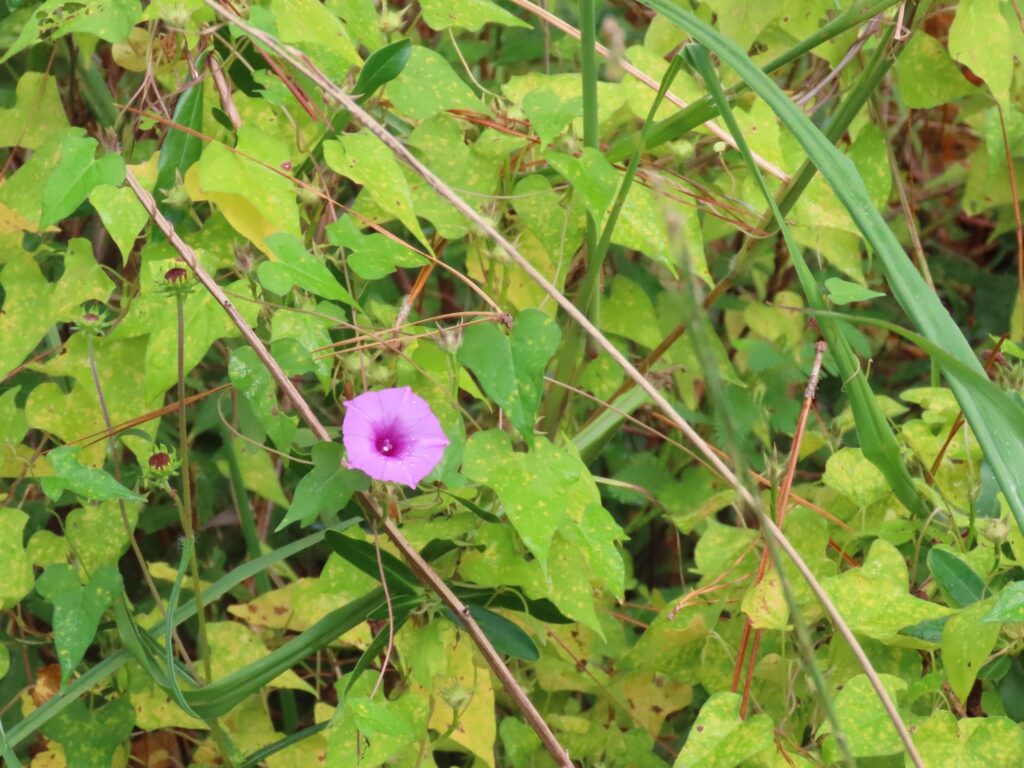

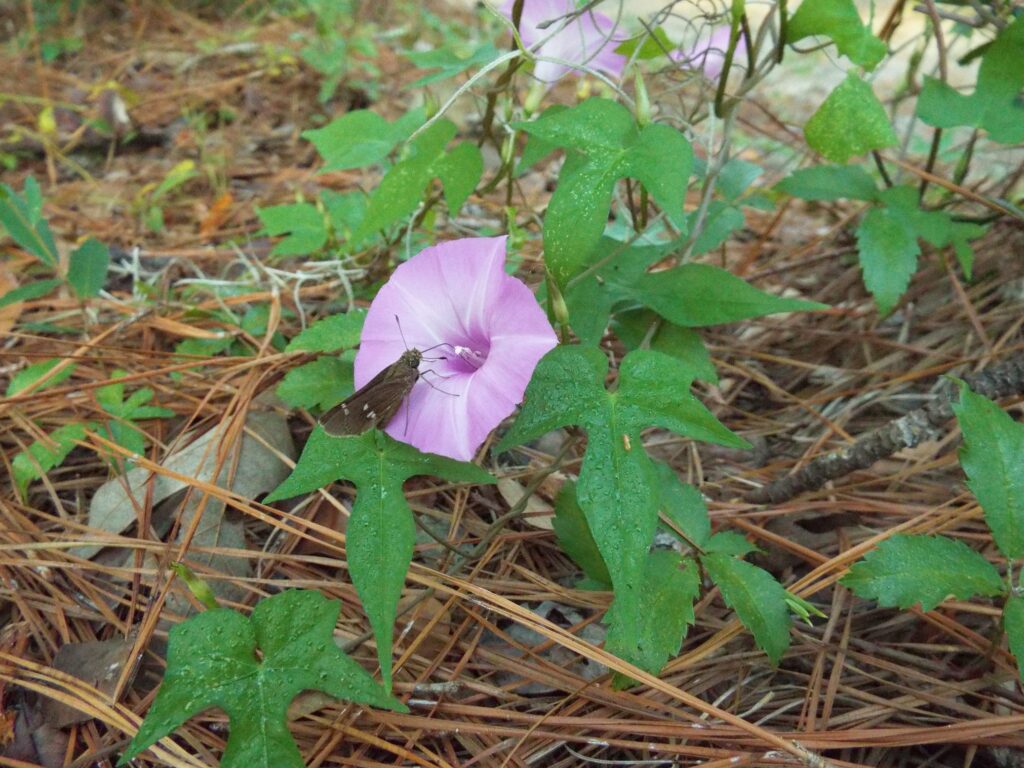
This week for Flora and Fauna Friday it’s a wiry, weedy, winding vine, Tievine (Ipomoea cordatotriloba).
Tievine is a native species of Morning-Glory found throughout the Lowcountry. It prefers open, sunny, disturbed habitats, like roadside, fence rows, wood lines, and old fields. It’s an annual herbaceous vine with fine twining lines of stems that grow up and over grasses, shrubs, and fences. Although thin, its stems are remarkably tough. It tolerates a wide array of soil fertilities and can become rather aggressive on moist, fertile soils. If you have a volunteer Morning-Glory coming up in a flower pot or garden bed in the Lowcountry, more often than not it’s a Tievine. Tievine’s leaves are a little less than palm-sized, are heart-shaped, and often three-lobed. Its peak bloom time begins in September and continues well into October. Tievine flowers are an inch-and-a-half wide trumpet that’s either round or a pentagon when viewed from the front. They’re a soft pink on the outside of the petals which funnels down into a deep magenta center. Flowers open one at a time at each node and each only lasts for a day, often closing by the time the midday day heat arrives. Tievine and other Morning-Glories are decent nectar plants for Hummingbirds, bees, and larger butterflies. It also helps create cover for mammals and birds in fields and other open areas, by growing like a net cast over nearby shrubs and structures.
This week for Flora and Fauna Friday we’ve got a veritable grab-bag of mud-molding insects to appraise, the Mason Wasps, Potter Wasps, and Mud-daubers of the Eumeninae subfamily and the Sphecidae and Crabronidae families.
The terms “mason”, “potter”, and “mud-dauber” are generalized terms used to describe several groups of wasps belonging to multiple families, there being three major families found in South Carolina. As their three-fold common names all imply, these wasps are renowned for their defining feature of working and shaping clay. These wasps either chew up soil or slurp up mud to create a clay paste. They then carry the clay to a suitable workshop where they form it into whatever shape they desire. These three generalized common names refer to the style and architecture of their ceramic creations but, ultimately, they’re all solitary wasps building earthen cradles for their offspring. The clay shelters the baby wasps from the elements and protects them from predators.
Mason Wasps and Potter Wasps both belong to the subfamily Eumeninae. Mason Wasps are cavity nesters. They don’t build free-standing nests and instead build nests in small holes or cavities, typically hollow stems and holes left behind by other insects. After they pack the nest full of food and lay their eggs, they cap it off with a plug of mud and start the next nest. Sort of like how a mason fills the gaps between bricks with mortar, Mason Wasps seal gaps in cavities with mud. It’s an efficient and simple strategy but ultimately the Wasp is dependent on existing holes to make nests. Thus this is a highly diverse group with each member specialized in taking advantage of all manner of food sources and cavity types.
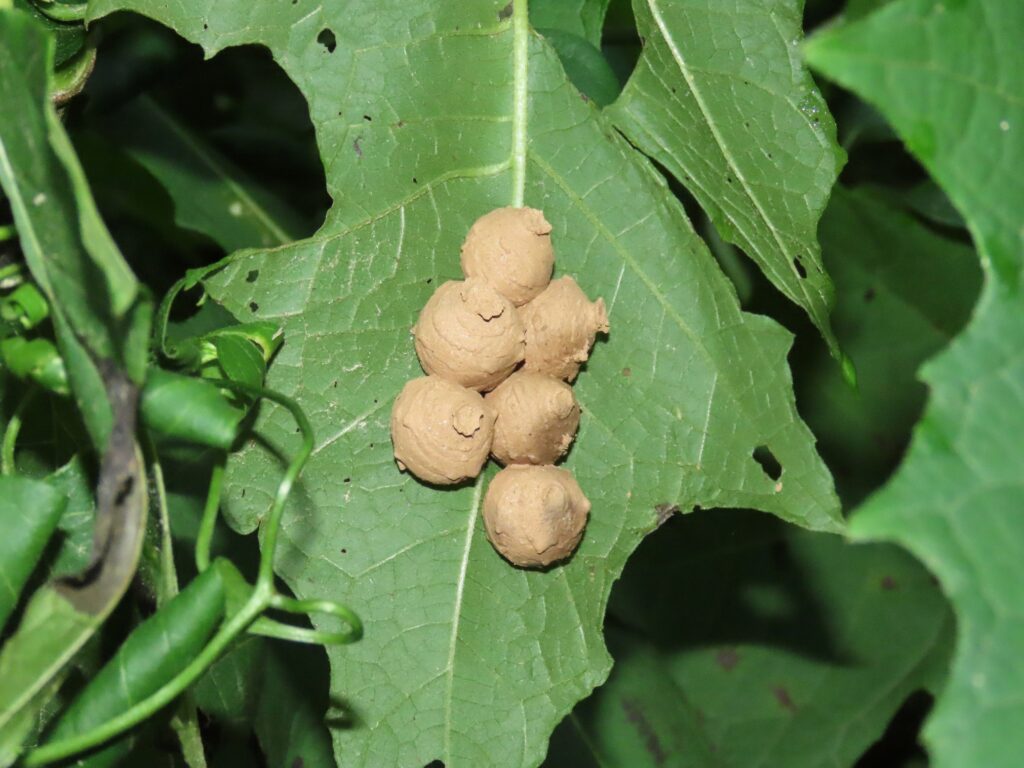
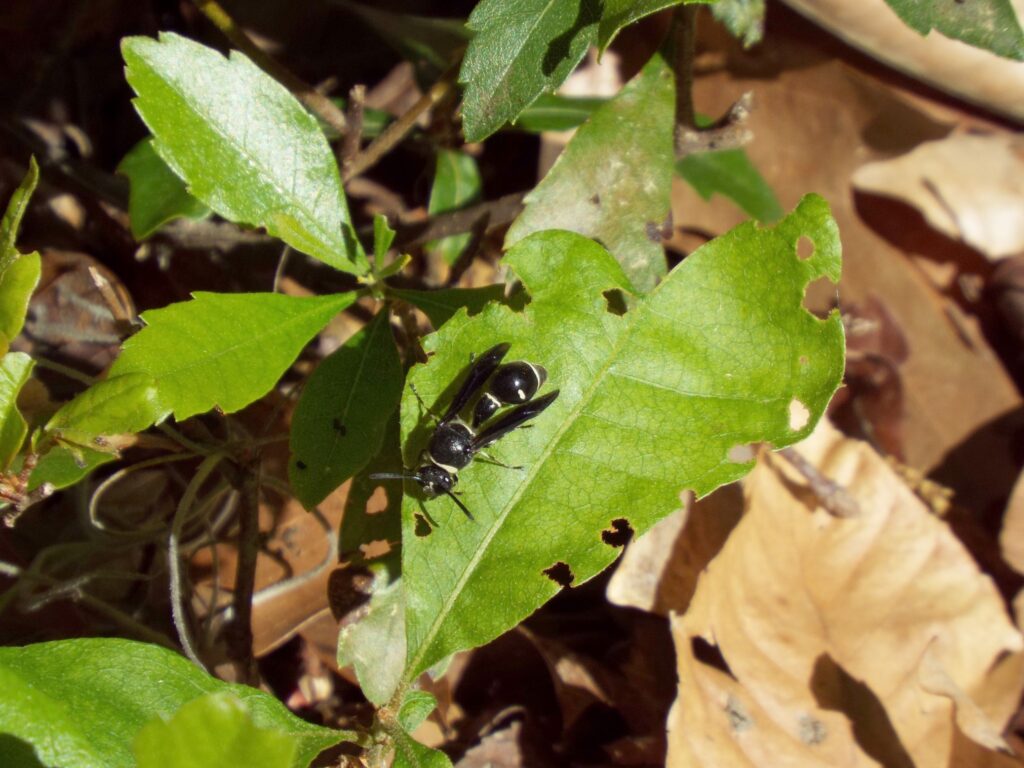
Potter Wasps, on the other hand, build free-standing nests. These nests are spherical and look like a crude earthenware urn, complete with a flared neck, spun on a potter’s wheel. They generally build these nests on the bottom of leaves or the shaded side of a building. They then stuff this urn full of paralyzed caterpillars before laying an egg within and sealing the top. The Fraternal Potter Wasp (Eumenes fraternus) is our prototypical Potter Wasp and widespread across the state. They’re less than an inch long with a round thorax, narrow waist, dark wings, and white markings on a black body.
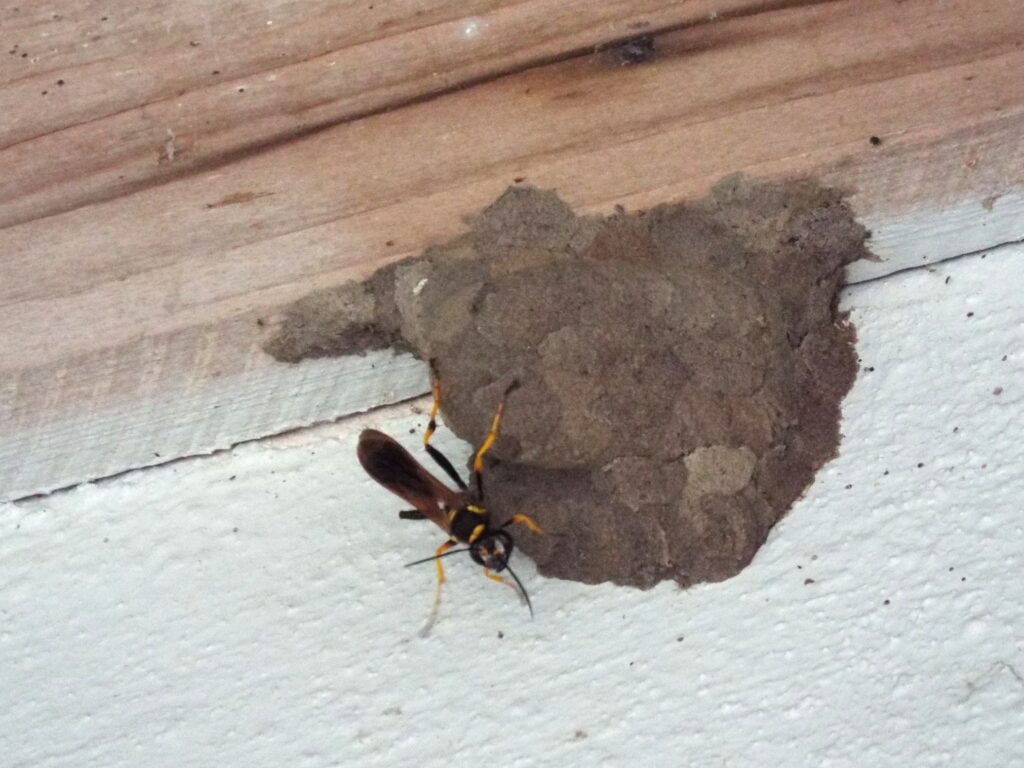


Mud-dauber Wasps also build free-standing nests but they adhere them to the side of vertical structures, like trees, rocks, and buildings. They also build large compound nests, generally with dozens of chambers. They daub mud slowly into a complex structure, just like how wattle and daub was used to build primitive houses. Mud-daubers stuff their nests full of spiders they’ve stung and paralyzed. I’ll highlight three common Mud-dauber Wasp species found throughout the state, each about an inch to inch-and-a-half in length. The Common Blue Mud-dauber (Chalybion californicum) has a metallic dark blue-green body and iridescent blue-black wings. They build disorganized mound-like nests, often with a lumpy, patchwork appearance. The Yellow-legged Mud-dauber (Sceliphron caementarium) has a black body, thread-waist, lemon-yellow legs and markings, and amber colored wings. They build boxy dome-shaped nests full of stacked cigar-shaped egg chambers. Both the Common Blue and Yellow-legged Mud-daubers belong to the Sphecidae family. The third belongs to the Crabronidae family, the Organ Pipe Mud Dauber (Trypoxylon politum). The Organ Pipe Mud-dauber is solid black, except for its iridescent blue-black wings and pale hind feet. They build rows of long tubular nests, all parallel to one another and each containing multiple chambers stacked on top of each other. These tubular nests resemble the array of pipes in a pipe organ.
Mason Wasps and Mud-daubers can both be a nuisance in their own right. (Potter Wasps not too much.) Mason Wasps love to build nests in vent tubes, drain lines, and bolt holes. Driving untold number of mechanics and technicians to madness. Organ Pipe and Common Blue Mud-dauber nests built on the side of houses can be an eyesore to many and are a pain to clean off of stucco. Yellow-legged Mud-daubers cause the same issues but they also have a special proclivity for ceiling fans and engine bays where they unbalance things that are supposed to be balanced and stuff dirt into things where dirt should not be stuffed. However, despite the nuisance and the several concussions I’ve nearly sustained from a Mud-dauber nest dislodging from a radiator fan at 3,000rpm, these Wasps play a critical role in our local ecosystems and provide several invaluable ecosystem services. First, these wasps drink nectar as adults and are stellar pollinators. Wasps are second only to bees in South Carolina in terms of pollination volume. Second, they hunt other insects. Potter and Mason Wasps generally hunt caterpillars. Moth caterpillars eat plants, for the most part, and are prone to large population swings. A ballooning caterpillar population can have radical impacts to its host plant’s population and can upset an ecosystem. Birds and reptiles can take advantage of these population swings, but they can’t grow their populations fast enough to control them. Yet, wasps can. So Potter and Mason Wasps play a critical role in controlling moth populations and stabilizing ecosystems. The same can be said for how Mud-daubers hunt spiders. Spiders eat a lot of pollinators and so they keep pollinator populations in balance. Mud-daubers in turn hunt the spiders, keeping spider populations in check and ensuring most pollinators can carry on their business as usual. Lastly, Potter Wasps and Mud-daubers make research easy for many entomologists. If an entomologist wants to study the local spider or moth populations, they can often just go find a fresh Mud-dauber of Potter Wasp nest, pop it off the wall, and crack it open in the lab like a creepy-crawly filled Kinder Egg. The arachnids and insects within the nest are alive but paralyzed by venom and are usually perfectly preserved specimens for study. This technique provides a wholly unique sampling method from anything researchers can replicate manually and has aided in the study of an untold number of arthropods!


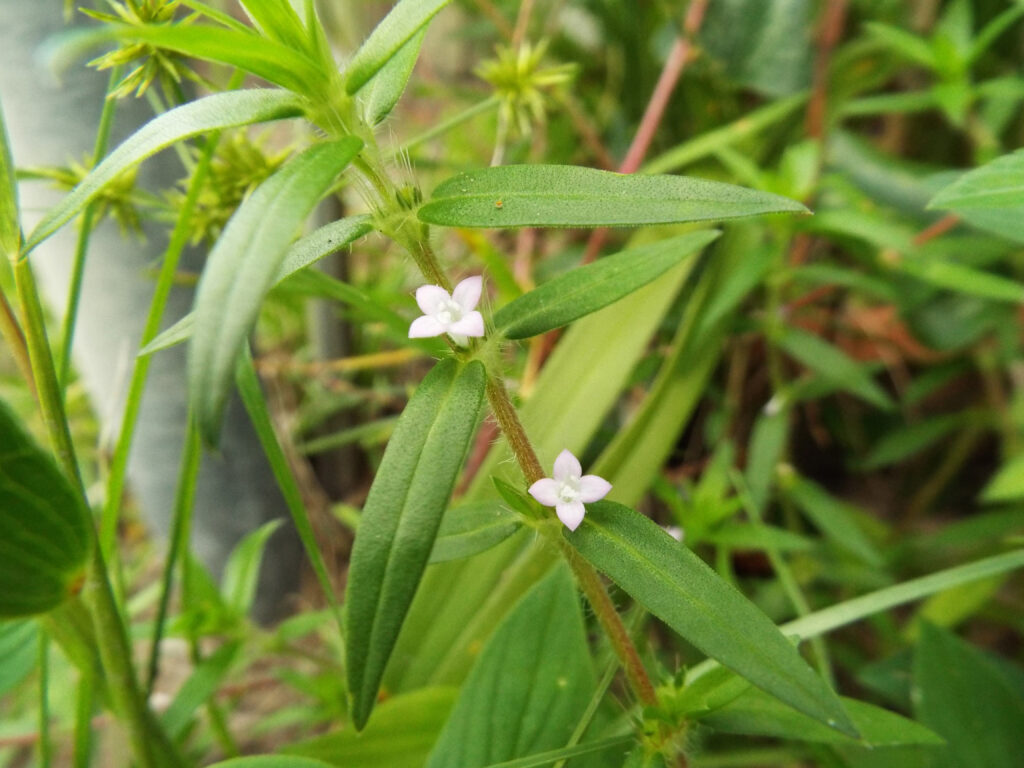

This week for Flora and Fauna Friday, we have an upland weed that fills a pollinator need, Poor-joe (Hexasepalum teres).
Poor-joe, also called Rough Buttonweed, is found on high, dry, upland soils all across South Carolina. It does best where little else grows, even on parched sands and gravel roads. Poor-joe is what’s called a pioneer plant, a species that is the first to re-colonize a heavily disturbed ecosystem. It grows in all manner of dry and sunny habitats, from eroded mountainsides in the Appalachian foothills, over top the Sandhills in the midlands, down to the sand dunes of our coastal barrier islands, and on every similar site in-between. Poor-joe usually grows about six inches high before branching and falling back down onto the ground around it. It repeats this patter and grows like this across the sand into a loose, limp bush or groundcover a foot or two across. Poor-joe’s leaves are held opposite and are narrow with a pointed tip and a prominent fold down the center. Its stems are sparsely hairy and usually a prominent burgundy color. It blooms in summer, peaking in August and September, and bearing a single flower at a time on each stem node. The flowers of Poor-joe are tiny and pastel-pink with four-pointed petals and white anthers. Although not particularly showy and despite their small size, Poor-joe is a great pollinator plant. Its flowers are often frequented by native bees and small butterflies where it provides a reliable source of life-giving nectar on the hottest of days in even the most barren of landscapes.